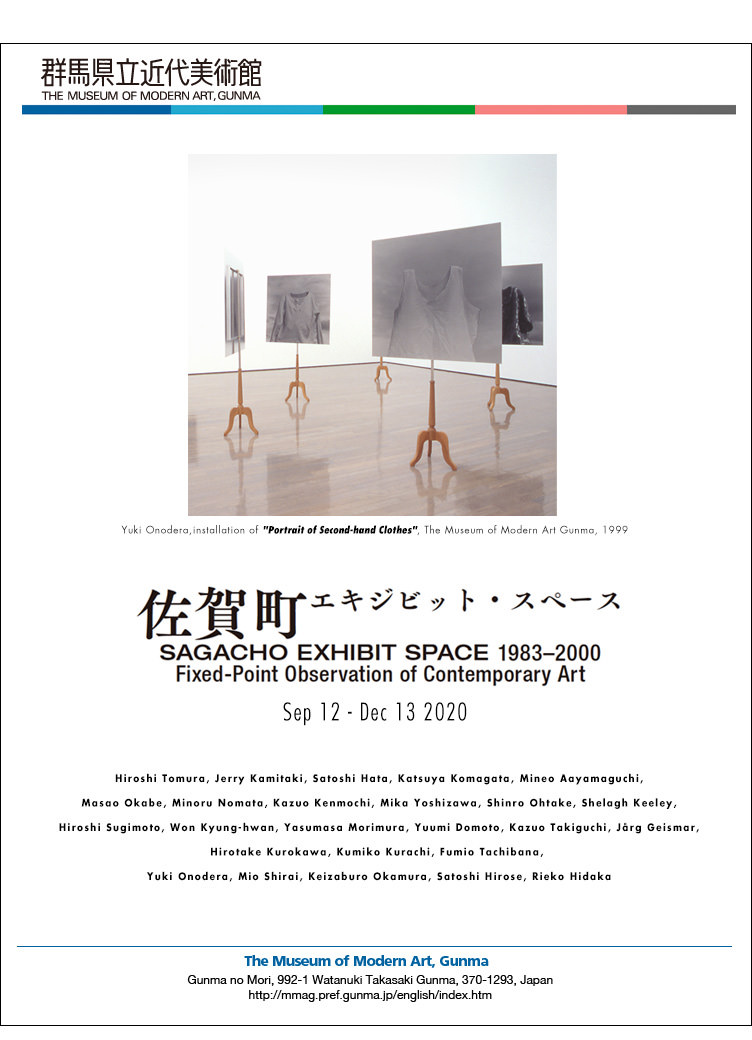Yuki Onodera
群馬県立近代美術館

Exhibiting artists: Hiroshi Tomura, Jerry Kamitaki, Satoshi Hata, Katsuya Komagata, Mineo Aayamaguchi, Masao Okabe, Minoru Nomata, Kazuo Kenmochi, Mika Yoshizawa, Shinro Ohtake, Shelagh Keeley, Hiroshi Sugimoto, Won Kyung-hwan, Yasumasa Morimura, Yuumi Domoto, Kazuo Takiguchi, Jårg Geismar, Hirotake Kurokawa, Kumiko Kurachi, Fumio Tachibana, Yuki Onodera, Mio Shirai, Keizaburo Okamura, Satoshi Hirose, Rieko Hidaka
In the 1980s, when contemporary art in Japan developed dramatically, the global art scene saw the development of many infrastructures that gave rise to new artists, such as the Kunsthalle in Germany (an art museum without a collection) and PS1 in New York (a renovated public elementary school with an exhibition gallery and artist-in-residence) in the United States.
Against this backdrop, Kazuko Koike, who was the advertising director for Parco and other companies, curated such exhibitions as INVENTIVE CLOTHES 1909-1939 (The National Museum of Modern Art, Kyoto, 1975) and The Design of Mackintosh (Seibu Museum of Art, 1979), and was also involved in the launch of MUJI, a pioneering private brand. She restored the third-floor auditorium of the Shokuryo Building (completed in 1927) in Saga, Koto-ku, Tokyo, and opened Sagacho Exhibit Space in 1983. As an experimental exhibition space that advocates an alternative art scene that is neither an art museum nor a commercial gallery, and that approaches artists seeking a place to present their work, Sagacho Exhibit Space had become the first “alternative space” in Japan that transcended the traditional genres of art, design, fashion, architecture, and photography, and attracted attention from abroad.
More than 400 artists from Japan and abroad were involved in the 106 exhibitions held at the Sagacho Exhibit Space, and until its closing in December 2000, the exhibitions continued to present a wide variety of ongoing art. The series of activities can be summed up in the term “fixed-point observation”. This exhibition traces the trajectory of contemporary art in Japan through fixed-point observations made at the Sagacho Exhibit Space over the 17 years of its operation.
岡部昌生、野又穫、剣持和夫、吉澤美香、大竹伸朗、シェラ・キーリー、
杉本博司、元慶煥、森村泰昌、堂本右美、滝口和男、ヨルク・ガイスマール、
黒川弘毅、倉智久美子、立花文穂、オノデラユキ、白井美穂、岡村桂三郎、
廣瀬智央、日高理恵子
日本の現代美術が飛躍的に発展した1980年代、世界のアートシーンには、ドイツにクンストハレ(コレクションを持たない美術館)があり、アメリカではニューヨークのPS1(廃校となった公立小学校を改修し展示ギャラリーとアーティスト・イン・レジデンスを併設)が先鞭をつけるなど、新しい作家を生むインフラストラクチャーの開発が多く見られました。
そのような状況の中、パルコなどの企画広告ディレクターであり、「現代衣服の源流展」(京都国立近代美術館、1975 年)や「マッキントッシュのデザイン展」(西武美術館、1979年)などのキュレーション、またプライベートブランドの先駆けでもある「無印良品」の発案立ち上げなどに関わった小池一子は、東京都江東区佐賀にあった食糧ビル(1927年竣工)の3階講堂を修復し、1983年に佐賀町エキジビット・スペースを開設しました。「美術館でも商業画廊でもない」もう一つの美術現場を提唱し、発表の場を求めるアーティストに寄り沿う姿勢を打ち出す実験的な展示空間として、佐賀町エキジビット・スペースは、美術、デザイン、ファッション、建築、写真といった従来のジャンルを超えた、日本初の「オルタナティブ・スペース」として海外からも注目される存在となりました。
佐賀町エキジビット・スペースで行われた展覧会は106回、関わった国内外のアーティストは400人以上にのぼり、2000年12月に幕を閉じるまで、多種多彩な現在進行形の美術を発信し続けました。その一連の活動は「定点観測」という言葉に集約することができます。本展は、開設から17年にわたる佐賀町エキジビット・スペースを拠点とした定点観測を通して、日本の現代美術の軌跡を辿るものです。
Design & developpement: ABC Japon